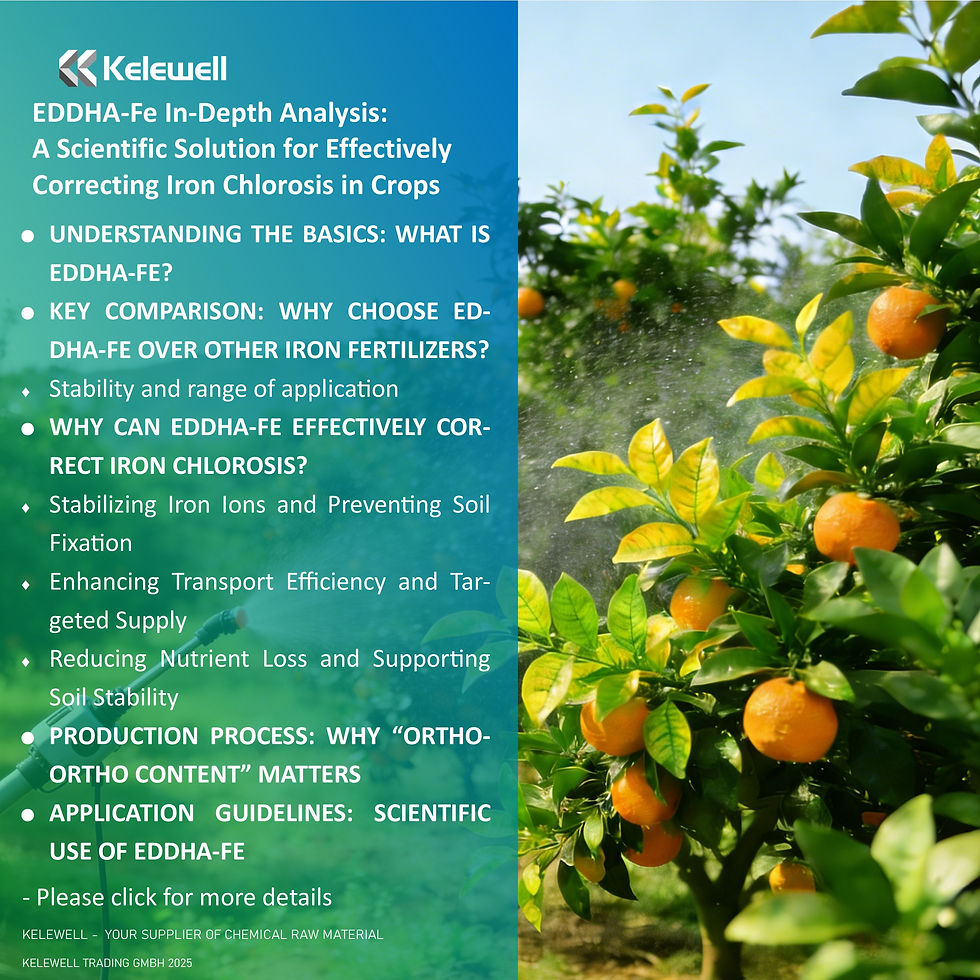China Fertilizer Market Brief – July 2025
- Fernando Chen

- Jul 28
- 4 min read
Core Market Overview
In July, China's fertilizer market was characterized by “weak supply and demand with diverging price trends.”
Potash fertilizers, after a dramatic roller-coaster fluctuation, gradually returned to rational pricing. Urea prices weakened both internationally and domestically. The phosphate fertilizer sector showed significant internal divergence, with phosphate rock remaining in a state of localized tight balance. Compound fertilizers were squeezed by both high production costs and sluggish demand.
Overall, the market sought a point of equilibrium amid the interplay between policy intervention and fundamental supply-demand forces.
I. Potash Fertilizer Market: Rational Correction After Sharp Fluctuations
In July, potash fertilizer prices in China exhibited a pattern of "sharp rise followed by a steep decline." After a mid-June upward trend, prices dropped significantly by mid-July, with monthly volatility reaching 450–580 RMB/ton.
This roller-coaster trend reflected a multi-dimensional struggle involving weak supply and demand, frequent policy interventions, and volatile market expectations.
1.1 Drivers of Market Fluctuation
• Tight Supply Side:
In June, imports of potassium chloride totaled only 650,000 tons, down 33.02% month-on-month.
Traders withheld or suspended sales, causing circulating supply to shrink.
Partial shutdowns of domestic production units in Qinghai, falling port inventories, and newly arrived cargoes largely entering bonded zones led to high supply concentration.
• Weak Demand Side:
Although autumn fertilizer stockpiling began and compound fertilizer plants resumed operations, downstream farmers remained cautious due to low crop prices.
High potash prices dampened purchasing enthusiasm among compound fertilizer producers, who adopted a “purchase-as-needed” approach.
1.2 Policy Interventions
• On July 15, seven key enterprises including China National Agrochemical Corporation jointly issued a proposal to ensure supply and stabilize prices.
The proposal offered price concessions based on early-June levels and publicized sales prices, leading to a reversal and decline in potassium chloride prices.
• The current “weak supply and weak demand” market pattern remains unchanged. While supply constraints exist, sluggish demand is suppressing further price increases.
1.3 Market Conditions and Trends
• Imported Potassium Chloride:
Port inventories continued to fall below 2 million tons.
Major enterprises accelerated de-stocking through low-priced sales.
Mainstream quotations for 62% white potash stabilized in the 3,150–3,400 RMB/ton range.
• Potassium Sulfate:
High raw material costs kept prices firm but hampered sales.
Ex-factory prices for 52% powder-grade remained at 3,950–4,000 RMB/ton, but actual transactions at high prices were limited, pushing up inventory pressure.
Operating rates of processing enterprises dropped to 55%–60%.
• Trend Forecast:
In the short term, prices will remain volatile at high levels.In the medium to long term, as supply improves and demand recovers, the market is expected to follow a “dip before rebound” trend.
Enterprises should strengthen cost control and resource integration, monitor port inventory dynamics, and follow the pace of new international potash capacity releases.
II. Urea Market: Retreat from High Levels, Marked by Volatility
In late July, the urea market continued its downward oscillation:
• China’s ex-factory prices dropped by 10–40 RMB/ton:
Shandong: 1,730–1,830 RMB/ton
Hebei: 1,740–1,760 RMB/ton
Henan: 1,810 RMB/ton
Shanxi: 1,680–1,700 RMB/ton
• International urea prices declined by USD 5–20/ton:
China bulk prilled urea FOB: USD 410–440/ton (low-end down by USD 20)
China bulk granular urea FOB: USD 435–450/ton (low-end down by USD 10)
Price corrections were observed simultaneously in regions such as the Black Sea, Iran, and Egypt.
Brazil granular CFR: USD 445–480/ton, with the high-end rebounding by USD 5
• Worsening supply-demand imbalance:
Domestic production remains high.
Agricultural demand is fading seasonally.
Industrial demand remains weak.
III. Phosphate Fertilizer Market: MAP Remains Firm, DAP Stagnates, Sector Divergence Intensifies
3.1 China Market
• MAP (Monoammonium Phosphate) Prices Rising:
Ex-factory price in Hubei for 55% powder: 3,410–3,430 RMB/ton
Delivered price in Shandong for 55% powder: 3,500–3,550 RMB/ton
Phase I quota sales are largely completed. Manufacturers are limiting new orders, supported by high sulfur costs and solid order backlogs. No detailed information is yet available for Phase II quota—awaiting policy guidance.
• DAP (Diammonium Phosphate) Prices Stagnant:
Ex-factory price in Hubei for 64% granular: 3,800–3,850 RMB/ton
Shandong warehouse-out price: 4,000–4,100 RMB/ton
Domestic demand remains weak, with market focus shifting to exports.
• Phosphate Rock Prices Stable to Firm:
Slight supply tightness in the north due to environmental inspections, and in the south due to transport issues—mines are holding firm on pricing.
Strong demand for high-magnesium and blended ores has pushed prices for 25%–31% grade rocks generally upward.
3.2 International Market
• DAP Prices at High Levels:India CFR price: USD 795–805/ton
• MAP Market Weaker:Export activity under Phase I quotas has largely concluded.
• Phosphate Rock Imports:Total imports from January to June 2025 reached 766,000 tons, mainly sourced from Egypt, Jordan, and Peru.
IV. Compound Fertilizer Market: High Costs, Slow Demand
• High Cost Pressure:
The overall production cost remains elevated due to raw material trends: urea fluctuating, MAP staying firm, and potash prices at high levels.
• Export Disruptions:
Export customs declarations for binary compound fertilizers have been suspended.
Inspection times for SSP (Single Superphosphate) and TSP (Triple Superphosphate) have been extended.
• Regional Demand Shows Significant Variation:
North and East China: Supported by topdressing needs for corn, enabling some localized transactions.
Central and Southwest China: Slow inventory clearance by distributors after drought conditions, leading to sluggish autumn pre-sales.
V. Industry Observation and Future Outlook
• Potash and urea markets are expected to remain in short-term downward correction with ongoing price volatility, reflecting a return to market rationality.
• Phosphate fertilizers may stay strong in the short term due to autumn demand and cost support, but caution is advised regarding the pace of exports and fluctuations in international markets.
• Enterprises should closely monitor supply-demand dynamics and policy developments, enhance cost control, and improve product adaptability to navigate the ongoing market uncertainty expected to continue into August.
Attention: The above information is for commercial reference only due to the diversity of information collected, and Kelewell is not responsible for the authenticity of the data.




Comments